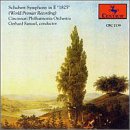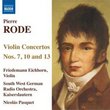| All Artists: Franz [Vienna] Schubert, Gerhard Samuel, Cincinnati Philharmonia Orchestra Title: Schubert: Symphony in E "1825" Members Wishing: 0 Total Copies: 0 Label: Centaur Release Date: 9/1/1993 Genre: Classical Style: Symphonies Number of Discs: 1 SwapaCD Credits: 1 UPC: 750582980435 |
Search - Franz [Vienna] Schubert, Gerhard Samuel, Cincinnati Philharmonia Orchestra :: Schubert: Symphony in E "1825"
 | Franz [Vienna] Schubert, Gerhard Samuel, Cincinnati Philharmonia Orchestra Schubert: Symphony in E "1825" Genre: Classical
|
Larger Image |
CD DetailsSimilar CDs |
CD ReviewsProbably a fake, but an enjoyable one David Bratman | San Jose, CA United States | 06/02/2004 (2 out of 5 stars) "So what is this work? You won't find it listed in catalogs of Schubert's music (it is NOT the Symphony in E of 1821, D.729).The liner notes claim that it is the rediscovered score of Schubert's Gastein Symphony, a work he's known to have written while staying in that town in the summer of 1825. Authoritative recent works on Schubert, such as Brian Newbould's "Schubert and the Symphony" (p. 211-2) say that it's been proven that the Gastein Symphony is the Great C Major, D.944, usually called No. 9, and that the year "1828" on its autograph score is a mistake or deliberate misdating of some kind. They don't even mention an alternative, though Newbould wrote a decade after this work's score was published. That's the first thing that should make you suspicious of the work in hand.Conductor Gerhard Samuel, in his liner notes, says the Symphony in E was found in the 1970s in the form of manuscript parts that, "depending on whom one reads," were copied either in the late 19th century or the 1960s. That two such widely separated dates could both be assigned to the same manuscript is the second thing that should make you suspicious.The third thing that should make you suspicious is listening to the work itself. Samuel admits that the symphony is full of quotes from other Schubert works, but claims this is no evidence of falsification because Schubert was prone to self-quotation.But there is a huge difference between using his songs "The Trout" and "Death and the Maiden" as variation themes in chamber music works, and the thinly and blandly altered motifs, quirks of orchestration, and other characteristic bits of the Unfinished Symphony, Great C Major Symphony, and other Schubert works that pervade this piece. Listen in the first movement to the tremulous string accompaniment at 1:53 and compare it to the main theme accompaniment in the first movement of the Unfinished, or to the forte outbursts at 2:22 and 2:59 and the trumpet and wind cadence at 4:03, which also come straight from the Unfinished, and ask yourself if you know any spots in Schubert's verified output where he repeated himself so blatantly and unimaginatively. Those are just among the first of a raft of obvious quotations.The experts on Schubert can't even be bothered to refute this work's authenticity, and my ears tell me that they're right to dismiss it so casually.However, if this is a fake, it's still a good one: enjoyable themes, imaginative construction, characteristically Schubertian outbursts, and an effective Schubertian orchestration. If you just enjoy listening to Schubert's mature symphonies, and the reconstructed D.729 and D.936A haven't sated your appetite for more, I'd recommend trying Bruckner's very Schubertian "Study Symphony" in F Minor (sometimes called No. 00) and this one. Whoever wrote it had a good Schubertian ear." A clumsy fake by an amateur composer who knows his Schubert Alan C. Parker | Simi Valley, CA USA | 06/23/2004 (2 out of 5 stars) "Not recommended--too many pointless modulations, some of which are to a wrong chord or wrong key--the scherzo is abruptly truncated and along with the finale contains material lifted from the 9th symphony along with inferior counterpoint--Schubert would never have let somthing like this escape from his pen--it has pleasant moments but, taken as a whole, is annoying to listen to. I'm sorry I wasted my money on it." Schubert Symphony or Party Album? You Decide. M. C. Passarella | Lawrenceville, GA | 09/02/2005 (3 out of 5 stars) "I say "party album," but obviously Gerhard Samuel and Centaur Records say "missing Schubert symphony," or they wouldn't have invested time and money in this project. Or maybe they would have. I can't speculate on the motives behind this release, so I'll describe what we have here as best I can.
And I say "as best I can" because Samuel, who writes the notes to the recording, doesn't have, or doesn't share, the full facts. What I can determine is that the "symphony" in question once existed in a score that has now vanished. What remains is a set of orchestral parts copied either in the late 19th century OR in the 1960s (sounds suspicious already, doesn't it?). The copying was supposedly done by a gifted amateur and is, in its current state, "unsuitable for performance." Enter one Gunter Elsholz "free-lance journalist, writer, and musician." He has constructed the performing version of the score used in this recording. I say "enter" Gunter Elsholz, but he really had a vested interest in the piece from the get-go because, you see, the "vanished" score was in the possession of "a branch" of Elsholz's family, and.... OK, it all seems pretty fishy to me too. So what does this "Schubert symphony" sound like? Well, it sounds very much like Schubert in parts. That's because it quotes from about a half dozen or so Schubert works written in the 1820s, among them the Octet, String Quartets Nos. 14 and 15, the Wanderer Fantasy, and the Great C Major Symphony; I think there is even a snippet from the Unfinished Symphony. All these bits and pieces sound pretty much like what they are--bits and pieces stitched together in a sort of potpourri fashion, which is to say not really a symphonic fashion that I can hear. At least, I'm assuming that if the same composer who had written the "Death and the Maiden Quartet" in 1824 and the Great C Major Symphony in 1825/26 had actually written this "symphony" in 1825, he would have been able to fashion the material into a fairly convincing sonata-style composition. Since such is not the case, I'm going to guess that what we have is one of two things: 1. a tribute to Schubert by some 19th-century composer in the manner of those grand fantasies that people like Hummel wrote on, say, the music of Mozart; or 2. a musicological hoax akin to Piltdown Man. In either case, the person in question would need access to compositions that didn't come to light until years after Schubert's death. So I incline toward Option No. 2, which is a lot more fun, but then I'm not a musicologist or even a free-lance musician. Anyway, except for an excruciatingly long and rambling first movement, the stuff here often sounds nice (it is fractured Schubert, after all), and is capably played by what I guess is a semi-pro orchestra. Gerhard expends obvious love and attention on getting it all right, or as right as it can be, given the material at hand. So it's worth a listen or two on its own merits and demerits. And then, of course, you can always whip this disc out and ask your friends "Did you hear the one about Franz Schubert and his long-lost Symphony in E Major?" " |

 Track Listings (4) - Disc #1
Track Listings (4) - Disc #1